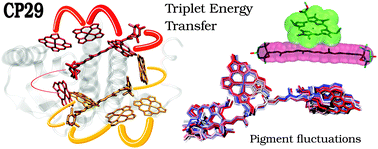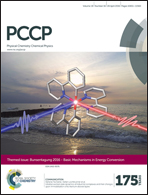Photoprotection and triplet energy transfer in higher plants: the role of electronic and nuclear fluctuations†
Abstract
Photosynthetic organisms employ several photoprotection strategies to avoid damage due to the excess energy in high light conditions. Among these, quenching of triplet chlorophylls by neighboring carotenoids (Cars) is fundamental in preventing the formation of singlet oxygen. Cars are able to accept the triplets from chlorophylls by triplet energy transfer (TET). We have here studied TET rates in CP29, a minor light-harvesting complex (LHC) of the Photosystem II in plants. A fully atomistic strategy combining classical molecular dynamics of the LHC in its natural environment with a hybrid time-dependent density functional theory/polarizable MM description of the TET is used. We find that the structural fluctuations of the pigment–protein complex can largely enhance the transfer rates with respect to those predicted using the crystal structure, reducing the triplet quenching times in the subnanosecond scale. These findings add a new perspective for the interpretation of the photoprotection function and its relation with structural motions of the LHC.


 Please wait while we load your content...
Please wait while we load your content...